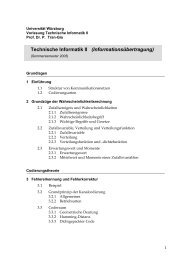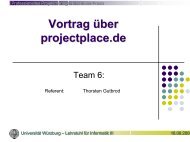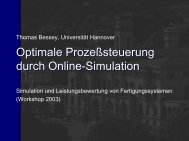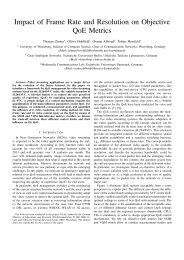Measurement and Analysis of Skype VoIP Traffic in 3G UMTS Systems
Measurement and Analysis of Skype VoIP Traffic in 3G UMTS Systems
Measurement and Analysis of Skype VoIP Traffic in 3G UMTS Systems
Create successful ePaper yourself
Turn your PDF publications into a flip-book with our unique Google optimized e-Paper software.
Table 1: Key performance measures for <strong>UMTS</strong> upl<strong>in</strong>k scenariothroughput deviation goodput deviation PESQm sent s sent m rcvd s rcvd Q[bps] [bps] [bps] [bps]µ 18071.58 2300.95 18055.23 3497.57 2.24σ 8.84 568.87 21.20 858.38 0.16Table 2: Received packets <strong>in</strong> the <strong>UMTS</strong> upl<strong>in</strong>k scenariopayload number mean PIT std. PIT3 Byte 3 20.02 s 10.73 ms108 Byte 847 61.97 ms 35.00 ms112 Byte 28 1.92 s 27.05 mscorrespond<strong>in</strong>g st<strong>and</strong>ard deviation (8.84 bps) <strong>of</strong> the <strong>in</strong>dividual runs is close to zero, as the samecodec with a fixed payload size <strong>and</strong> PIT was used <strong>in</strong> each <strong>of</strong> the ten experiments. However,s sent <strong>and</strong> s rcvd differ by about 1200 bps <strong>in</strong> the upl<strong>in</strong>k. Due to the jitter <strong>in</strong> the network theobserved PITs are almost uniformly spread around the mean PIT, which is also reflected <strong>in</strong> thelower PESQ value (2.24) as compared to the bottleneck LAN scenario (2.95) with the b<strong>and</strong>widthrestriction to 64 kbps.To highlight these effects <strong>in</strong> more detail, Table 2 shows the packets received at the DSLclient dur<strong>in</strong>g a s<strong>in</strong>gle run <strong>of</strong> the experiment. As before, the 3 Byte packets are used for qualityfeedback. However, this specific <strong>Skype</strong> codec uses two types <strong>of</strong> packet (108 Byte <strong>and</strong> 112 Byte)<strong>in</strong> the ma<strong>in</strong> audio stream. Thereby every 32th packet is <strong>of</strong> size 112 Bytes, which expla<strong>in</strong>s whythe mean PIT <strong>of</strong> the 108 Byte packets is 61.97ms <strong>in</strong>stead <strong>of</strong> 60ms. The high st<strong>and</strong>ard deviation<strong>of</strong> the PIT <strong>of</strong> these packets confirms our previous statements. The same behavior was observed<strong>in</strong> all n<strong>in</strong>e rema<strong>in</strong><strong>in</strong>g experiment runs.4.2.2 Downl<strong>in</strong>k: Wirel<strong>in</strong>e user sends to <strong>UMTS</strong> subscriberIn this scenario we regard the opposite direction, where the DSL user sends its voice data overa 128 kbps l<strong>in</strong>k to the <strong>UMTS</strong> user, who has a downl<strong>in</strong>k capacity <strong>of</strong> 384kbps. Thereby the<strong>in</strong>terest<strong>in</strong>g effects occur on the l<strong>in</strong>k from the base station to the <strong>UMTS</strong> mobile.Figure 11(a) shows the CDF <strong>of</strong> the PIT at the DSL sender <strong>and</strong> the <strong>UMTS</strong> receiver. Likebefore, the packets are sent <strong>in</strong>to the network exactly every 60ms. The <strong>UMTS</strong> receiver, however,registers a different behavior <strong>of</strong> the <strong>in</strong>com<strong>in</strong>g packets. The PIT <strong>of</strong> the arriv<strong>in</strong>g packets is nolonger uniformly spread around the mean PIT, but ma<strong>in</strong>ly takes three discrete values, 40ms,60ms, <strong>and</strong> 80ms. The difference <strong>of</strong> these values, corresponds to a <strong>UMTS</strong> Transmission TimeInterval (TTI) value <strong>of</strong> 20ms. As can be seen by the CDF, about 60 percent <strong>of</strong> all packetsarrive with a PIT <strong>of</strong> 60ms at the <strong>UMTS</strong> receiver. Approximately every 5th packet misses thecorrespond<strong>in</strong>g TTI, cf. Figure 11(b), <strong>and</strong> subsequently arrives with a PIT <strong>of</strong> 80ms. Thereforethe next packet, which hits the correct TTI, has a PIT <strong>of</strong> 40ms <strong>in</strong>stead <strong>of</strong> 60ms. This means that20 percent <strong>of</strong> all packets have a PIT <strong>of</strong> 80ms <strong>and</strong> 40ms, respectively.10
















